.
4.07.2014
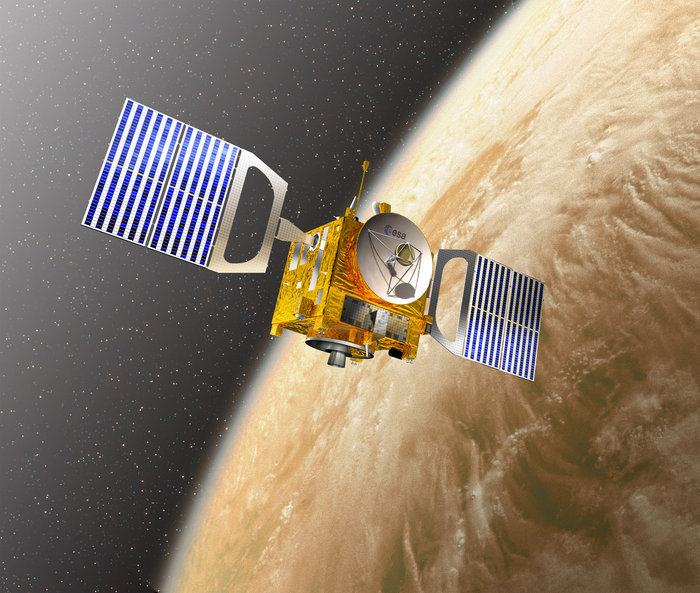
The 1.3-m-diameter High Gain Antenna for communications is visible on the front side of the spacecraft. Also visible are the specially designed solar arrays, which feature lines of radiators disposed between lines of solar cells to radiate excess heat while operating in a highly demanding thermal environment around Venus.
Venus Express is ESA's first mission to Earth's nearest planetary neighbour, Venus. The mission was born after ESA asked for proposals, in March 2001, suggesting how to reuse the design of the Mars Express spacecraft.
Built by an industrial team led by EADS Astrium, the 1,270-kg spacecraft was launched from Baikonur atop a Soyuz-Fregat vehicle on November 9, 2005 and will arrive around the planet in April 2006. Once in Venusian orbit, the probe will manoeuvre toward an elliptical polar orbit. At its closest, it will reach an altitude of 250 kilometres and at its furthest, it will be 66 000 kilometres away from the planet. The mission is due to last for two Venusian days, i.e. about 500 Earth days.
The probe's payload comprises a combination of spectrometers, spectro-imagers and imagers covering a wavelength range from ultraviolet to thermal infrared, a plasma analyser and a magnetometer to study the atmosphere, the plasma environment and the surface of Venus in great detail. Most of the instruments are re-using designs or even spare hardware from the Mars Express and Rosetta programmes. As the platform, they have been adapted to cope with the thermal and radiation environment in Venus orbit.
.
Das Ende der achtjährigen Erfolgsstory bei der Erkundung unseres Nachbarplaneten Venus naht: Europas Raumsonde Venus Express wird im Laufe des Jahres in die höllische Atmosphäre der Venus stürzen und verglühen. Für die letzte Phase haben die Flugingenieure des Europäischen Kontrollzentrums ein anspruchsvolles Zusatzprogramm entwickelt. Die Venus wird zum Testareal für zukünftige Landungen auf dem Mars.
Auch die erfolgreichste Raumsonde gibt irgendwann ihren Geist auf. Spätestens dann, wenn ihre Tanks leer sind. Dieses Schicksal droht in absehbarer Zeit der europäischen Mission Venus Express. Die im November 2005 gestartete Sonde befindet sich seit April 2006 in der Umlaufbahn unseres inneren Nachbarplaneten.Spätestens Ende des Jahres wird sie jedoch unwiderruflich in der dichten Atmosphäre der Venus verglühen.
Die Forscher sind mit dem bisherigen Missionsverlauf höchst zufrieden. Die für eine anderthalbjährige Einsatzzeit ausgelegte Planetensonde arbeitet nun schon im neunten Jahr.Auch sechs der an Bord befindlichen sieben Forschungsinstrumente funktionieren noch immer tadellos. Hierzu gehören Spektrometer, ein Plasma-Analysator, eine Kamera und ein Magnetometer.Deshalb verlängerte die ESA mehrfach die Missionszeit, letztmals bis zum 31. Dezember 2014.
.
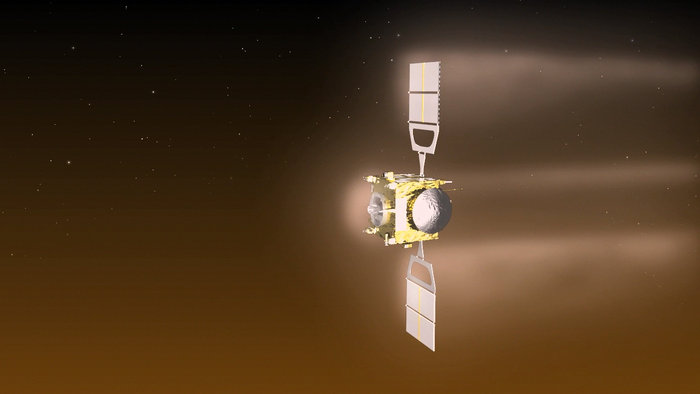
Bei dem Aerobraking-Manöver wird die Bahnhöhe über der Venusoberfläche bis auf 130 km abgesenkt.
.
Für die Endphase haben sich die Verantwortlichen im Europäischen Satellitenkontrollzentrum ESOC in Darmstadt ein Bonusprogramm der besonderen Art einfallen lassen. Es heißt „Aerobraking“ oder „Atmosphärenbremsung“. Darunter versteht man die gezielte Veränderung der Umlaufbahn eines Raumflugkörpers durch Reibung an den Gasen der planetaren Atmosphäre. Das universelle Verfahren kann an allen Körpern im Weltraum angewandtwerden, die eine Atmosphäre besitzen.
Aerobraking-Manöver dienen der Bremsung des Raumflugkörpers. Sie werden für die Rückführung von Kapseln sowie für Vorbeiflüge an Planeten genutzt. Am häufigsten wird das diffizile Verfahren bei interplanetaren Missionen genutzt. Die Geschwindigkeit der ankommenden Raumsonde liegt oft über der Fluchtgeschwindigkeit des Planeten. Erst durch Abbremsen wird die Sonde in eine Umlaufbahn um den Planeten gelenkt. Ist die Endbahn aber zu flach, entweicht die Raumsonde ins Nirwana des Weltraums. Ist die Bahn zu steil, verglüht sie.
Erfolgreiches Aerobraking, das heißt die sichere Durchquerung der oberen Atmosphärenschichten, setzt deshalb detaillierte Kenntnisse des Zielobjektes voraus.Einige Marsmissionen der Sowjetunion und der USA scheiterten am Aerobreaking, da die Atmosphäre des Roten Planeten wesentlich komplizierter ist, als zunächst angenommen. Auch der ESA-Lander Beagle gehört hierzu.
Testfeld für Marslandung
Die ESA-Spezialisten nutzen die Venusatmosphäre, umdas Aerobrakingverfahren bei unterschiedlichen Bedingungen zu testen. Diese Erfahrungen werden der zweiteiligen ExoMars-Mission zugute kommen, deren Starts für 2016 und 2018 vorgesehen sind. Da eine Atmosphärenbremsung die für die notwendigen Bremsmanöver mitzuführenden Treibstoffvorräte reduziert, könnte die Nutzlastkapazität der Marssonden allein durch ein zielgenaues Aerobraking und ein modifiziertes Design gesteigert werden.
Bei der 2016 startenden ExoMars-Mission führt der Orbiter zunächst nur einen Landedemonstrator mit. Gelingt die Generalprobe – die weiche Landung des Demonstrators auf der Marsoberfläche – gibt es grünes Licht für den Start des europäischen Marsrovers im Jahre 2018.
.
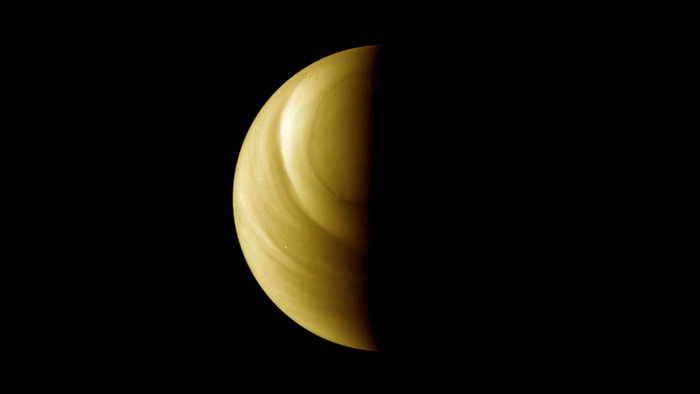
A screenshot from a new animation of an orbit of Venus, taken from data collected by ESA's Venus Express spacecraft.
The movie begins from a staggering 66 000 km above the south pole, staring down into the swirling south polar vortex. From this bird’s-eye view, half of the planet is in darkness, the ‘terminator’ marking the dividing line between the day and night sides of the planet.
The movie is based on images snapped by the Venus Monitoring Camera over a period of 18 hours during one of the spacecraft’s 24-hour orbits around the planet on 7–8 January last year. It was compiled using public data from the Venus Express data archive.
Quelle: ESA
,
Update: 11.07.2014
.
VENUS EXPRESS RISES AGAIN
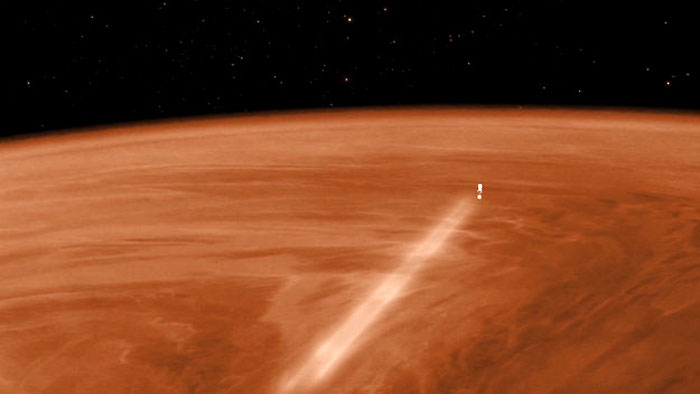
After a month surfing in and out of the atmosphere of Venus down to just 130 km from the planet’s surface, ESA’s Venus Express is about to embark on a 15 day climb up to the lofty heights of 460 km.
Since its arrival at Venus in 2006, the spacecraft has been conducting science observations from an elliptical 24-hour orbit that took it from a distant 66 000 km over the south pole – affording incredible global views – to altitudes around 250 km at the north pole, just above the top of the planet’s atmosphere.
After eight years in orbit and with fuel for its propulsion system running low, a daring aerobraking campaign was planned as a final assignment for Venus Express, during which it would dip progressively lower into the atmosphere on its closest approaches to the planet.
Thus routine science operations concluded on 15 May, and the spacecraft’s altitude was allowed to drop naturally from the effect of gravity, culminating in a month ‘surfing’ between 131 km and 135 km above the surface.
Additional small thruster burns were used to drop the spacecraft to lower altitudes, reaching 130.2 km earlier this week. Tomorrow, it is expected to dip to 129.1 km.
“We have explored uncharted territory, diving deeper into the atmosphere than ever before,” says Håkan Svedhem, ESA’s Venus Express project scientist.
“We’ve measured the effects of atmospheric drag on the spacecraft, which will teach us how the density of the atmosphere varies on local and global scales.”
Indeed, the additional drag exerted by the denser atmosphere at lower altitudes reduced the spacecraft’s orbital period by more than an hour.
Small changes in the spacecraft’s acceleration were also recorded due to variations in the atmospheric density along its orbital path. Differences in acceleration were also noticed between the day and night side of the planet.
The forces experienced by the spacecraft at different altitudes equate to a difference in atmospheric density of about thousand times between 165 km and 130 km, causing significantly increased stress on the spacecraft.
Indeed, the Venus Express team monitored the rapid heating that the spacecraft experienced as it skimmed through the upper reaches of the atmosphere during each orbit at about 36 000 km/h.
“During several of the 100-second long passages through the atmosphere, the solar panel temperature sensor reading increased by over 100ºC,” describes Adam Williams, ESA’s Venus Express spacecraft operations manager.
“Analysing the spacecraft’s response to such rapid heating will be useful for planning future spacecraft systems and subsystem design.”
Quelle: ESA
.
Update: 6.12.2014
.
VENUS EXPRESS WILL RAISE ORBIT AND KEEP GOING
Between 23 and 30 November the operations team at ESOC will conduct manoeuvres to raise the pericentre of the Venus Express (VEX) orbit again, in an effort to keep the spacecraft in productive orbit around Venus.
These manoeuvres could be the last for VEX due to low propellant levels, but all being well, VEX will continue its valuable scientific observations into 2015. The question is: how much longer can the spacecraft operate?
Venus Express has been in a reduced science phase since its orbit was changed following the hugely successful aerobraking campaign during the summer of 2014. The mission, originally planned for two-plus-two (two years nominal operation with a two-year extension) years, has been successfully collecting critical science data from the ‘Morning Star’ for over eight years now.
“This has been a fantastic mission and a great achievement for science over the last eight years and Venus Express continues to return excellent scientific data,” states Håkan Svedhem, Venus Express Project Scientist.
“The spacecraft remains healthy after this year’s demanding aerobraking campaign and return to scientific productivity, and we’re looking forward to getting as much science as possible while the fuel lasts.”
Lifting the orbit
Due to a combination of effects from the gravity of Venus and our Sun, VEX’s closest point of approach, the pericentre, is constantly descending closer to Venus. This ‘decay’ of the pericentre altitude would eventually damage the spacecraft (due to drag) if it is not raised away from the atmosphere.
The OCMs taking place now are using the spacecraft’s thrusters to lift the satellite at controlled increments back to a safer orbit. Without them, the pericentre altitude falls around 3 to 5 km per day.
As a result of the successful aerobraking manoeuvres earlier this year, the nominal 24-hr orbital period has been reduced to just over 22 hrs. Given that the routine flight control procedures followed for the last eight years – science planning, observations, ground station passes, reaction wheel offloading – were designed for a 24-hr orbit, the change of orbital period by nearly two hours has affected many aspects of planning and operations for the flight control team.
“It’s increasingly demanding to fly the spacecraft during this reduced science phase due to the changed orbit,” says Adam Williams, acting Spacecraft Operations Manager of Venus Express at ESOC.
“For most of our mission, we had a very regular 24-hour orbit. Now, we’re in a 22-hour orbit and this results in varying periods for science and ground station passes, so our operations tempo is much more irregular and very demanding.”
Correcting orbital decay
The OCMs scheduled for this month will correct the natural decay that has occurred since the PRM (pericentre raising manoeuvres) conducted in July, after the aerobraking activity.
“Aerobraking was very successful in July. It’s a credit to the designers that we have such a robust spacecraft capable of these demanding manoeuvres, and to the operators that they have kept it working so well. The mission has continued for much longer than its planned nominal lifetime and will likely continue even further,” explains Patrick Martin, Venus Express Mission Manager.
Adding to the challenge, the team won’t know if each manoeuvre has been successful until the following day’s communications pass. In one case, they will have to wait two days for their telemetry to return due to ground station availability constraints.
How much fuel do we have?
Everything now hangs on the amount of fuel and oxidiser on board the spacecraft.
It is calculated that there is around 3 kg of fuel and 5 kg of oxidiser remaining, although some of this may not be usable due to movement of propellant in the tanks. Estimates indicate around 1.4 kg of fuel and 2 kg of oxidiser are needed for the manoeuvres.
However, it’s impossible to be certain just how much propellant is actually available and the mission’s continuation into 2015 has been approved on the assumption that propellant remains available.
Whatever happens, once the fuel is exhausted, this hugely successful mission will come to a natural end.
A monumental mission
The Venus Express mission has observed Venus for over eight years and returned startling and amazing data from Earth’s nearest planetary neighbour. Observations have focused on the structure, dynamics, composition and chemistry of the dense atmosphere and overlying clouds. VEX also investigated the swirling vortex at the planet’s south pole.
VEX discovered Venus’ surprisingly cold region high in the planet’s atmosphere, and the high-altitude ozone layer. The mission confirmed that Venus is losing water from its upper atmosphere and that it may have been much more humid and Earth-like.
Some observations of the surface terrain were possible with the Visible and Infrared Thermal Imaging Spectrometer (VIRTIS). The data provide the best evidence to date that Venus has been volcanically active in recent geological times. In the upper atmosphere, large variations of sulphur dioxide have been discovered.
Toward the end of an era
VEX continues going strong, generating valuable scientific data, and is expected to continue to do so in robust health into 2015. The satellite itself is in excellent condition, as are all its functional instruments.
"It is a bit sad to know that sooner or later the spacecraft will run out of propellant," says ESA's Andrea Accomazzo, Head of the Solar and Planetary Missions Division at ESOC and the first Venus Express Spacecraft Operations Manager.
"When we launched Venus Express, nobody thought it would last this long. This spacecraft has been operating in a very demanding environment for many years; with this mission we could capitalise and consolidate our early experiences with Rosetta and Mars Express. This all contributed to the now very well established capability at ESA to conceive and operate interplanetary missions.”
“Venus Express is, after Rosetta and Mars Express, the most recently launched of ESA’s interplanetary jewels. It was supposed to be a short mission, but the robustness of the spacecraft and the skills of our operations and flight dynamics teams have made it a much longer lasting, incredibly successful mission,” says Paolo Ferri, Head of Mission Operations.
“Its mission at Venus has been not only a major scientific achievement, but also very important for our teams to gain experience in operating a probe so close to the Sun. This will be extremely useful also for the preparation of the upcoming BepiColombo mission to Mercury.”
Quelle: ESA
---
VENUS EXPRESS ANOMALY
On 28 November 2014, the flight control team at ESOC reported loss of contact with Venus Express.
It is possible that the remaining fuel on board VEX was exhausted during the recent periapsis-raising manoeuvres and that the spacecraft is no longer in a stable attitude (the spacecraft’s high-gain antenna must be kept pointed toward Earth to ensure reliable radio contact).
Repeated attempts to re-establish contact using ESA and NASA deep-space tracking stations have been made since then, and there has been some limited success in the period since 3 December.
Although a stable telemetry link is not available, some telemetry packets were successfully downlinked. These confirm that the spacecraft is oriented with its solar arrays pointing toward the Sun, and is rotating slowly.
The operations team is currently attempting to downlink the table of critical events that is stored in protected memory on board, which may give details of the sequence of events which occurred over the past few days. The root cause of the anomaly (fuel situation or otherwise) remains to be established.
We will provide an update as soon as something more concrete is known.
Today, Venus Express is in the eighth year of its fantastic mission – pretty good for a satellite originally designed for just two years of orbiting in Venus' challenging conditions.
Quelle: ESA
.
Update: 17.12.2014
.
VENUS EXPRESS Mission geht langsam zu Ende
.
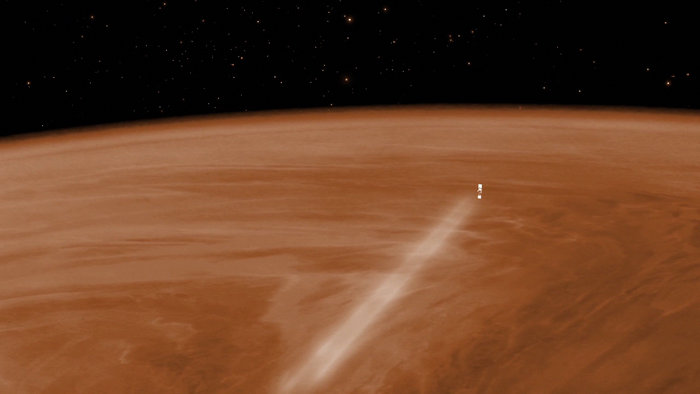
ESA’s Venus Express has ended its eight-year mission after far exceeding its planned life. The spacecraft exhausted its propellant during a series of thruster burns to raise its orbit following the low-altitude aerobraking earlier this year.
Since its arrival at Venus in 2006, Venus Express had been on an elliptical 24‑hour orbit, traveling 66 000 km above the south pole at its furthest point and to within 200 km over the north pole on its closest approach, conducting a detailed study of the planet and its atmosphere.
However, after eight years in orbit and with propellant for its propulsion system running low, Venus Express was tasked in mid-2014 with a daring aerobraking campaign, during which it dipped progressively lower into the atmosphere on its closest approaches to the planet.
Normally, the spacecraft would perform routine thruster burns to ensure that it did not come too close to Venus and risk being lost in the atmosphere. But this unique adventure was aimed at achieving the opposite, namely reducing the altitude and allowing an exploration of previously uncharted regions of the atmosphere.
The campaign also provided important experience for future missions – aerobraking can be used to enter orbit around planets with atmospheres without having to carry quite so much propellant.
Between May and June 2014, the lowest point of the orbit was gradually reduced to about 130–135 km, with the core part of the aerobraking campaign lasting from 18 June to 11 July.
After this month of ‘surfing’ in and out of the atmosphere at low altitudes, the lowest point of the orbit was raised again through a series of 15 small thruster burns, such that by 26 July it was back up to about 460 km, yielding an orbital period of just over 22 hours.
The mission then continued in a reduced science phase, as the closest approach of the spacecraft to Venus steadily decreased again naturally under gravity.
Under the assumption that there was some propellant still remaining, a decision was taken to correct this natural decay with a new series of raising manoeuvres during 23–30 November, in an attempt to prolong the mission into 2015.
However, full contact with Venus Express was lost on 28 November. Since then the telemetry and telecommand links had been partially re-established, but they were very unstable and only limited information could be retrieved.
“The available information provides evidence of the spacecraft losing attitude control most likely due to thrust problems during the raising manoeuvres,” says Patrick Martin, ESA’s Venus Express mission manager.
“It seems likely, therefore, that Venus Express exhausted its remaining propellant about half way through the planned manoeuvres last month.”
Quelle: ESA
5208 Views
